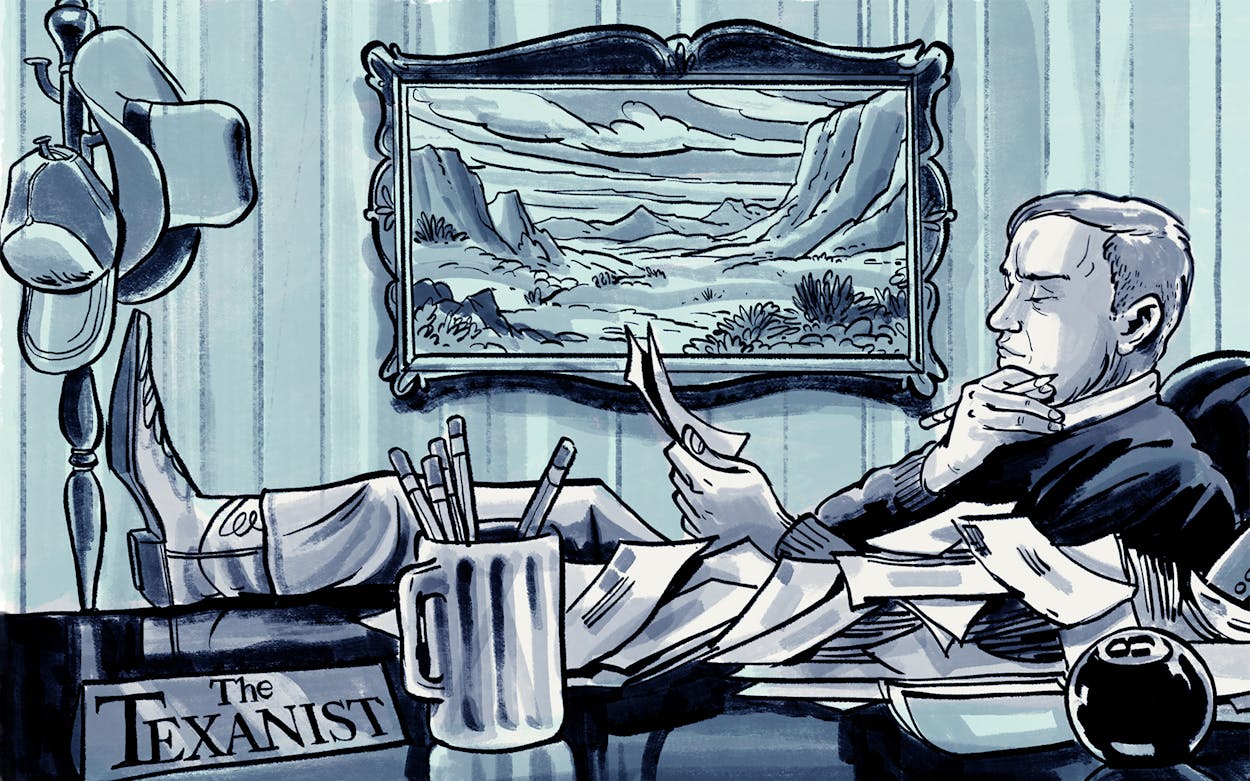Q: There seems to be no end to one of the most persistent misconceptions about Texas. I speak of the saguaro cactus. We constantly see images of this stately, tree-like cactus in reference to the Lone Star State: billboards, cowboy art, murals, books, magazines, and countless Tex-Mex menus. A recent New Yorker had a short story set in Texas with an illustration of a cowboy riding past a saguaro. And now, New Yorker staff writer (and longtime Texas resident) Lawrence Wright’s new book, God Save Texas: A Journey into the Soul of the Lone Star State, has a map of the state with, you guessed it, a saguaro in the middle of Big Bend. There is just one problem: the saguaro is not native to Texas. It occurs naturally only in the Sonoran Desert, in southern Arizona and parts of California and Mexico. Will the Texanist please intervene and help put an end to this botanical fallacy?
B.C. Robison, Katy
A: Saguaro (pronounced “sah-wah-roh”) cactus, the largest cactus found in all of the United States, can reach heights in excess of seventy-five feet, may live for more than two hundred years, and is certainly an impressive specimen of cactus. The Texanist, while on a recent golf trip to the Scottsdale area, was able to witness its gargantuan grandiosity first hand. They really are something. But, speaking personally, he found them to be just a bit ostentatious in their enormity and, truthfully, a little weird looking, standing there solemnly as they do. The Texanist will never forget the strange sight and downright otherworldly sound of a badly hooked tee shot piercing the skin of, and being completely swallowed up by, one of these green giants. Fore! (FYI, the United States Golf Association’s Rule 28, which addresses unplayable balls, applies in such cases and will, sadly, cost you a stroke.)
Pardon the Texanist for that brief digression. Because the saguaro is, in the eyes of some, such a looker, visual depictions of the Southwest and the West in general are often enhanced with these Sonoran showboats. But you are absolutely right that we Texans never encounter them in our actual native habitat—not even in our western Chihuahuan Desert parts. If given a binary choice between our own prickly pear and saguaro, the Texanist will choose the unpretentious and down-to-earth (literally) prickly pear every time. He just finds them more attractive. Plus, the prickly pear is a much more useful plant than the saguaro, providing Texans with delicious nopalitos and thirst-quenching prickly pear margaritas that are, with their striking magenta hues, as pretty as they are tasty.
With all of this in mind, the Texanist is happy to do what he can to right this longstanding canard of deserty iconography.
So, hear y’all! Hear y’all!
Be it now known, once and for all, that while the Lone Star State is so lousy with prickly pear cactus that it is our official state plant, and that, additionally, while Texas is home to more than a hundred other cactus species, ranging in size from the thousand-pound fishhook barrel cactus to the tiny button cactus, a wider assortment of cacti than that possessed by any other state in the union, the saguaro, as B.C. Robison of Katy has clearly and correctly stated in his prickly May, 2018, plea to yours truly, ain’t one of ‘em. And don’t forget it!
How’s that? It was strong and to the point, right? You know, Dallas psychorockabilly musician the Reverend Horton Heat preached this very sermon in his jaunty 2009 tune, “There Ain’t No Saguaro in Texas.” It’s the perfect theme song for the anti-saguaro movement. If you haven’t heard it, give it a listen. But to further bolster this public service effort, the Texanist has come up with his own handy mnemonic device to help the point stick more thoroughly. And it goes a little something like this:
The Lone Star State has so much darn cactus
Naming them all takes Aggie-style practice
But from Beaumont to El Paso
You’ll find not one (naturally occurring) saguaro
So please don’t use them in artwork pertaining to Texas.
That should take care of that [sound of work gloves coming off].
By the way, in an effort to get to the bottom of the saguaro situation in God Save Texas, which is an otherwise superb work, the Texanist reached out to Mr. Wright, an esteemed Texas Monthly veteran, to see what exactly went wrong. The offending saguaro, which is featured in an illustrated map on the book’s endpaper, was apparently added at the last minute, right before the book went to press. “I didn’t even notice it until a reader scolded me for including it,” an admirably sheepish Wright admits. “Now I just consider it artistic license.”
Have a question for the Texanist? He’s always available here. Be sure to tell him where you’re from.
A version of this is published in the January 2019 issue.
- More About:
- The Texanist
- Lawrence Wright









